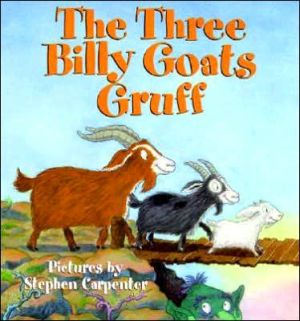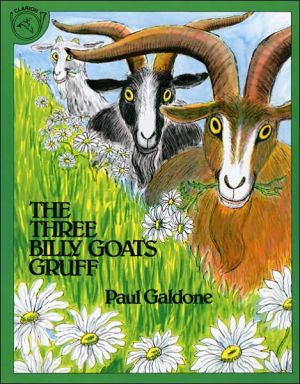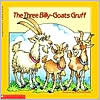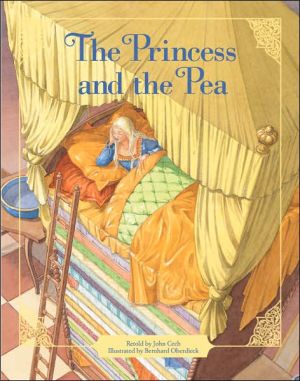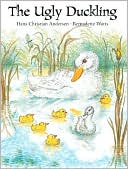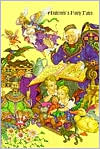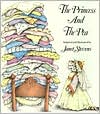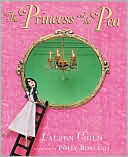Three Billy Goats Gruff
This classic story is a favorite with toddlers, who will cheer on the three clever billy goats who outsmart a mean troll. With plenty of repetition, this adventure is perfect for reading aloud and for joining in, and a satisfying ending provides a reassuring touch.\ \ \ Three clever billy goats outwit a big, ugly troll that lives under the bridge they must cross on their way up the mountain.\
Search in google:
This classic story is a favorite with toddlers, who will cheer on the three clever billy goats who outsmart a mean troll. With plenty of repetition, this adventure is perfect for reading aloud and for joining in, and a satisfying ending provides a reassuring touch.Publishers WeeklyRounds's pedestrian retelling of the familiar Norwegian folk tale about the billy goats who trick a mean troll lacks the verve and vitality that has made the story a favorite of kids around the world. Reminiscent of children's crayon drawings, the illustrations--set against ample white backgrounds--feature a yellow sun outlined with black rays that hangs in a blue pencilled sky, and a scraggly hillside where ``the grass is so tall and green and tender.'' The eponymous animals, however, seem neither brave nor clever, and the troll hardly surly enough to make the story work. There is almost no character differentiation between the smallest goat, who goes trip-trapping across the troll's bridge and the biggest Billy Goat Gruff, who butts the troll from the bridge. Nor do the frequent use of exclamation points, changes in font size and capital letters compensate for the lack of either storytelling voice or drama in the straightforward text. This tale is better served by previously published renderings, such as the standard Paul Galdone version. Ages 4-8. (Apr.)
\ Publishers Weekly\ - Publisher's Weekly\ Rounds's pedestrian retelling of the familiar Norwegian folk tale about the billy goats who trick a mean troll lacks the verve and vitality that has made the story a favorite of kids around the world. Reminiscent of children's crayon drawings, the illustrations--set against ample white backgrounds--feature a yellow sun outlined with black rays that hangs in a blue pencilled sky, and a scraggly hillside where ``the grass is so tall and green and tender.'' The eponymous animals, however, seem neither brave nor clever, and the troll hardly surly enough to make the story work. There is almost no character differentiation between the smallest goat, who goes trip-trapping across the troll's bridge and the biggest Billy Goat Gruff, who butts the troll from the bridge. Nor do the frequent use of exclamation points, changes in font size and capital letters compensate for the lack of either storytelling voice or drama in the straightforward text. This tale is better served by previously published renderings, such as the standard Paul Galdone version. Ages 4-8. (Apr.)\ \ \ \ \ Children's Literature\ - Marilyn Courtot\ The three goats want to cross the river to get at the lush green grass on the other side. However, a very mean green troll controls the bridge. The billy goats are clever and they manage to outwit the troll. It is a traditional story given fresh treatment with Carpenter's illustrations. He ably shows the billy goats' fear of the horrible troll, but not such that it will cause any trauma to young readers.\ \ \ School Library JournalPreS-Gr 3--Through bold strokes and fine lines, Rounds creates three goats to be reckoned with and a troll who exudes nastiness. A bare-bones retelling of an old tale that will never be "told out." (June 1993)\ \ \ \ \ School Library JournalPreS-Gr 3-- A kinetic retelling of a beloved tale. Using no-nonsense language and his trademark minimalist drawings, Rounds strips the story down to the bare essentials, recapturing its time-tested appeal. With hairy, scratchy-looking skin, a huge wart on a pickle-shaped nose, bloodied extremities, and poor posture, the Troll makes the perfect bad guy. Splatters of brown-gray charcoal color float around the outline of his body, giving him an offensive aura. When the biggest Billy Goat Gruff appears on the scene, a face-forward drawing featuring a bristly goatee beard, ornery eyes, and a set of broad shoulders lets everyone know that this is not some cud-chewer. A dramatic double-page spread, filled with movement and emotion, captures the conflict as the two foes charge one another. After the goat butts his enemy with ``hard horns'' and tramples him with ``sharp hooves,'' another striking illustration shows the troll's grasping hands as he slips below the bridge. Readers are left with the reassuring image of the three goats grazing peacefully on a hillside. While carefully preserving the essence of the Norwegian tale, Rounds freshens it up with his unique perspective and style. Make room for this one next to the classic versions by Paul Galdone (Houghton, 1979) and Marcia Brown (Harcourt, 1957). --Joy Fleishhacker, New York Public Library\ \ \ \ \ Carolyn PhelanSpare and straightforward in text and illustrations, this interpretation of the old tale has an energy lacking in more elaborate versions. Rounds' goats, nobbly and irascible animals that you wouldn't want to meet on a bridge over a river, play out their roles forcefully. Vitality of line is the distinguishing feature of the black ink brushwork paintings. Shaded, mottled crayon markings color the scenes here and there with good effect, and the broad white pages make a bright, clean background for the action. Well suited to unsentimental preschoolers, this is an engaging version of an old favorite.\ \ \ \ \ Kirkus ReviewsIn this entry in the Growing Tree series, the publisher copyrights the text, while Carpenter provides illustrations for the story; here, the three billy goats named Gruff play on a nasty troll's greed to get where the grass is greenest. Logic has never been the long suit of this tale: Instead of letting the two smaller billy goats be terrorized by the mean and ugly troll, children wonder, why doesn't the biggest billy goat step in sooner? It's still a good introduction to comparatives, and the repetitiveness of the story invites participation. The artwork matches the story: The characters are suitably menacing, quivering, or stalwart, and the perspectives allow readers to be right there in the thick of the action. (Picture book. 2-4)\ \
